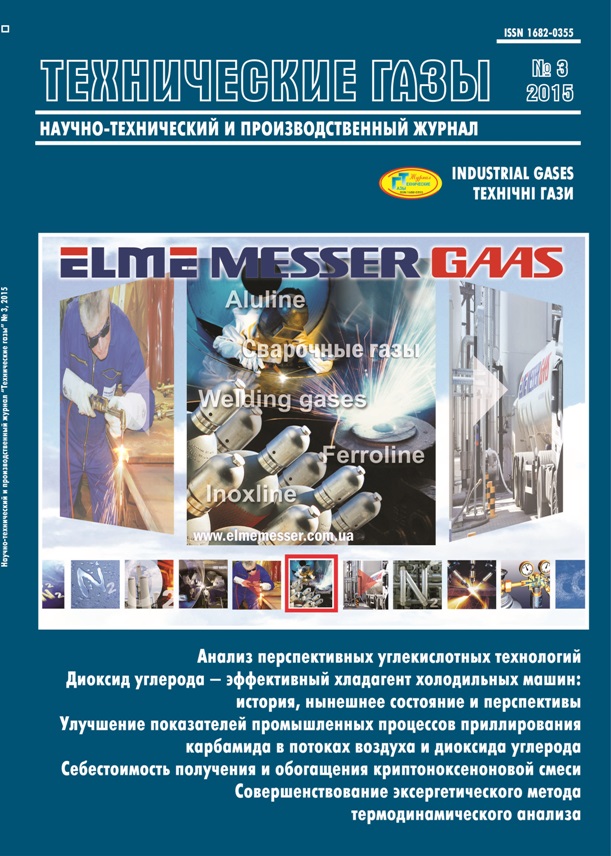THE CARBON DIOXIDE USAGE AS AN EFFECTIVE WORKING FLUID IN THE REFRIGERATION MACHINES: HISTORY, CURRENT STATUS AND PROSPECTS
DOI:
https://doi.org/10.18198/j.ind.gases.2015.0775Keywords:
Refrigeration machine, Heat pump, Natural refrigeration agents, Carbon dioxide, The cooling coefficient, Conversion efficiency, The extent of thermodynamic perfection, The compressor of VorhisAbstract
As the working substance vapor compression refrigeration machines (VCRM) and heat pumps (HP) can use different gases. These include not only specifically synthesized chemical compounds, but also natural refrigerants - ammonia, carbon dioxide, hydrocarbons. Described cooling cycles useful for work a carbon dioxide (R744). Discussed subcritical, transcritical, throttle, and throttle-expander cascade cycle in which carbon dioxide used as the low-temperature refrigerant circuit. Attention paid to the analysis of the merits of carbon dioxide cycle, which enabled the compressor of Vorhis. Shows a comparison the characteristics of the throttle cycles at different temperatures cooling, one- and two-stage compression. Is set out short history of creation refrigeration units and heat pumps operating on CO2, indicated their main manufacturers producing equipment, taking into account characteristics of the working substance which be used. The advantages of heating and cooling systems working on carbon dioxide, compared with systems using alternative refrigerants.
References
Hovalyig D.M., Sinitsyin K.M., Baranenko A.V., Tsoy A.P. Energy efficiency and environmental safety of low-temperatures engineering// Science Magazine NIO ITMO. Series «Refrigeration and Air Conditioning». — 2014. — № 1 [Electronic resource]. Access code: http://www.inbt.itmo.ru/ articles/1058.pdf. (Rus).
Tsvetkov O.B. Refrigerants, refrigerants and refrigeration oils — nostalgia for the future [Electronic resource]. Access code: http://holodko.ru/freon/Tsvetkov_Themophys.pdf. (Rus).
Fisher S.K., Fairchild P.P., Hughes P.S. Global warming implications replacing CFC//ASHRAE Journal. — 1992. — April. — P.14–19.
Zheleznyiy V.P., Semenyuk Yu.V. (2012). Working body parokompressornyh chillers: properties, analysis and application. — Odessa: Feniks. — 420 p. (Rus).
NIST Reference Fluid Thermodynamic and Transport Properties (REFPROP. Version 9.1): [U.S. Department of Commerce]// National Institute of Standards and Technology. — Gaithersburg, Maryland, 2013.
Dossat R.J., Moran T.J. (2001). Principles of Refrigeration. —Upper Saddle River, — 454 p.
Vaynshteyn V.D., Kantorovich V.I. (1972). Low-temperature refrigeration units. — М.: Food production. — 351 p.
Martyinovskiy V.S., Meltser L.Z. (1964). Ship refrigeration units. — М.: Transport, — 383 p.
Martyinovskiy V.S. (1950). Chillers. — М.: Pischepromizdat. — 256 p. (Rus).
Kharlampidi D.H., Sherstyuk A.V., Bratuta E.G. (2011). Thermodynamic analysis of supercritical cycle refrigerating machines and heat pumps// Energy saving. Energy. Energy audit. — № 8 (90). — P. 43–48. (Rus).
Lavrenchenko G.K., Khmelnyuk M.G. (2003). The perfection of refrigaration machine with refrigerant recharging of compressor’s cylinder. 1. The Production of cold at one lever of temperature// Tekhnicheskie Gasi. [Industrial Gases]. — — № 2. — P. 16–24. (Rus).
Lavrenchenko G.K., Khmelnyuk M.G. (2003). The perfection of refrigaration machine with refrigerant recharging of compressor’s cylinder. 2. The Production of cold at two levels of temperature// Tekhnicheskie Gasi. [Industrial Gases]. — № 4. — P. 16–19. (Rus).
Cooling systems CO2 for food retail stores. Design subcritical and transcritical CO2 systems and the selection of the necessary equipment, produced company «Danfoss»// LTD «Danfoss». — 2009 [Electronic recurs]. access code]. access code: www.danfoss.com/ СО2. (Rus).
Gorbenko G.A., Chayka I.V., Gakal P.G., Turna R.Yu. (2009). Application of carbon dioxide in refrigerating technologies// Tekhnicheskie Gasi. [Industrial Gases].— № 4. — P. 18–22. (Rus).
Kalnin I.M., Pustovalov S.B., Krivtsov D.V. (2013). The scale and prospects of using heat pumps R744// Kholodilnaya tehnika. [Refrigeration Engineering]. — № 3. — P. 22–26. (Rus).
Tovazhnyanskiy L.L., Kapustenko P.A., Havin G.L. (2007). Features of the application of the refrigerant CO2 (R744) in heat pumps// Integrated technologies and energy efficiency. — № 3. — P. 23–26. (Rus).
Pustovalov S. Heat pumps of the new generation on the carbon dioxide (R744)// Bulletin of the Russian Academy of Natural Sciences. — № 1. — P. 81–86. (Rus).
Suhodolskaya A.B., Kochetov V.P. (2006). Environmental and energy analysis of prospects for the application of alternative refrigerants in the heat pumps// Kholodilnaya teh-nika i tehnologiya. [Refrigeration Engineering and Techno-logy]. — part 2. — № 4 (102). — P. 77–84. (Rus).
Dyachenko O.V. (2006). The use of natural refrigerants in the systems of heat and cold processes// SОК. — №10 — P. 98–101. (Rus).
Viman U. The complete elimination of useless losses (2010). // Informatsionnyiy byulleten po holodilnyim siste-mam. — №1. — P. 4–5. (Rus).
[Electronic resource]. Access code: www.danfoss. com/ nr/ rdonlyres/ 4a74d6ca-c8ba-4f44-bc09-e8cdec334cff/1669/kom_co3.pdf.
[Electronic resource]. Access code: http://uash. com.ua/ files/bitzer20years.pdf.
Kozmalov S.N., Bonfanti M. (2014). Usage of Dorin compressors in CO2-technologies // Kholodilnaya tehnika. [Refrigeration Engineering]. — № 2. — P. 28–31.
Downloads
Issue
Section
License
LICENSE AGREEMENT
After receiving an article for publication as required revision scientometric databases each author directs the license agreement on the assignment and transfer of the management of copyright. Signatures of the author (s) it is desirable to seal the personnel department of the institution where the author works (authors), or the seal of the Faculty.
Revision refers to the authors one layout for proofreading. Permissible only those fixes that result in compliance with the layout of the original text of the article. Significant changes are not permitted. Layout should be sent to the editorial office within days of receipt.

